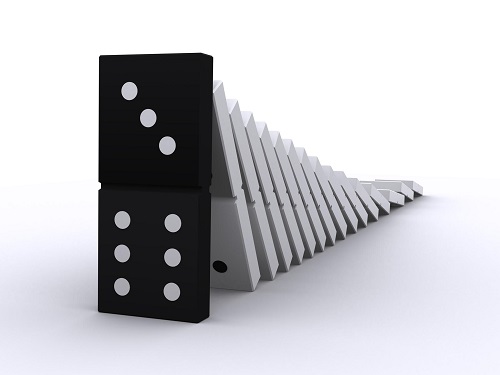This comment was left on one of my previous Minimalist Monday posts:
"I have so much junk (good stuff) — not sure where to start or how to get rid of anything!! HELP!"
Just start. Starting is the hardest part. If you've ever had to move, you likely stood in your home, new boxes and tape in your hand, and felt entirely overwhelmed. Where do I begin? There is just so much.
Eventually, you just picked something, put it in a box and started a domino effect. Or maybe you decided to pack up a certain room.
Minimalism is a little like that. You just have to start.
Pick a room — or if that's too big a job, a closet. If that's too much, a drawer. Go through it and start getting rid of unnecessary stuff. Donate what you can, recycle what can't be donated, and throw away the rest.
With each item ask yourself: Do I need this? Do I use this regularly?
Take it a small project at a time. If you spend fifteen minutes organizing a drawer, getting all the unnecessary junk out, it's a 15 minutes well spent. (It shouldn't take you that long, but even if it takes 20 minutes, again, time well spent).
Not only will you have a tidy drawer, but you will feel a sense of accomplishment. You'll also experience how great it feels to purge and get your space a little more minimalist. That part is most important, because it will help power you through more projects.

If the idea of spending your time purging and organizing is off-putting, remind yourself of the advantages: cleaning (and keep things neat and tidy) is much easier when you have less "stuff." No "losing" things or not being able to find them (or worse — spending hours wading through a million things trying to find something you need). Remember that you'll have a more organized and less chaotic (and cluttered) space when you're finished. You'll also feel more relaxed and at ease. "Stuff" and "clutter" cause stress and anxiety. The benefits to minimalism are endless and different for everyone. Keep sight of your reasons and motivations.
Next, and this may be the most important part. In fact, this is something you should do before you open the drawer: you have to accept minimalism.
Let's take a look back at the comment: "I have so much junk (good stuff)" — this is where the problem often lies. It's how we end up with so many possessions that possess us. This line of thinking is what gets us in a cluttered state.
Just because something is "good" doesn't mean we need to keep it (or buy it in the first place).
In my "How to Become a Minimalist" post, I wrote: "We live in a society based around consumerism, keyword: consume. You have to reject consumerism and accept minimalism. Bigger is not better. Think "downsize," not "supersize." Vote for simplicity.
Check out my Book Series on Minimalism.
For example, you do not need two irons, even if they both work. Keep one and donate the other. Less is more.
Just getting rid of "duplicates" can make a huge difference and sometimes "duplicates" are not that obvious. For example, I had a scanner, but my printer also worked as a scanner. I don't do the kind of work where I scan very often, so it didn't make sense for me to have two "scanners," especially when the printer scanner works just fine. I gave the scanner to a friend who is starting her own business and now it's getting used rather than just sitting in my office.
Sure, I could have told myself the scanner is still good (it's not broken) and I do use it sometimes, and it's not even that big, so why get rid of it? But that's the trap minimalism helps you avoid. If you do that with everything, you won't get anywhere. You'll just become more cluttered.
That's why it's so important to accept minimalism. Really take in that "less is more" approach and develop the instinct that you should look for reasons to remove something, not keep it.
Some minimalists try to limit their total number of possessions. For example, a popular "plan" is aiming to only own 100 items. I'm not there yet. I don't think I ever will be, but I find I cherish, use, and appreciate the things I do have now way more than I did when my apartment was busting at the seams with 10x more stuff.
For example, even with a closet full of clothes (plus suitcases packed full of still more clothes under my bed), I only wore about 20 to 30% of my wardrobe. I have about a fourth of clothes now (maybe even less) but I wear (and love!) every item. Same with shoes. I had at least three dozen pairs. Many were covered with dust — I wore them that infrequently. Now I don't even have a dozen pairs, yet I wear them all the time. Some get worn more than others — for example, my sandals get a lot more love than my high heels, but my high heels still get worn regularly.

Sometimes I think "too many options" is a bad thing. That was certainly the case for me with shoes and clothes. (If you're looking for a good, but big, first project — clothes and shoes are great choices!!! If you haven't worn it in a year, send it to the donation center so someone who needs it can wear it.)
By the way, when you have less stuff, you'll be amazed at how creative you can get with solutions.
And this couldn't be more true with clothes. I'm constantly finding new outfits in my closet. Mixing and matching to make a totally new outfit. I'm amazed by it really, especially when I used to stare at a closet overfilled with clothes and think I have nothing to wear, or I'd always pick the same outfit and never try something new. Less really is more.
If you have a hard time letting go of possessions, or you like to keep things because you think "I might need it someday" read my posts about clutterbugs (Part 1 and Part 2). They will help you understand why you feel this way and how you can work around it.
Check out my Book Series on Minimalism.
Also remember that donating, or even throwing things away, isn't a loss. It's a gain. If you're donating, you're helping change someone's life.
Nevertheless, if you're still not ready to purge, there are other things you can do to start easing into minimalism, like clearing everything off of your counters. Or organizing your pantry, though you do want to throw out expired food items for safety ;)
When you are ready to start purging, here's how to filter through your belongings. Each item should fit into one of these categories:
1. Sell
2. Donate
3. Recycle
4. Discard
5. Keep (and use)
Great places to start are your garage, attic and basement. If it's sitting in a box in your garage or attic, and you haven't used it in the last 6 months or a year, do you really need it? Probably not if it's just collecting dust.
One of my minimalist students made this comment recently and I really loved it: "Why use your home as a storage facility?"
Same goes for sentimental items. If you haven't looked at it or touched it in the last year, can it really be that sentimental to you?
Now don't get me wrong, I have sentimental items in my house, but they're in my house (not a box) and I enjoy them regularly. Whether it's actually using them (i.e., a vase that was handed down) or just looking at them (i.e., a picture on the wall) — they are "used." I had been carting around a lot of my childhood toys that I cherished for years. Thinking I'd eventually give them to my children when really, I just didn't have the heart to part with them. I did still go in and look at them once or twice a year. What did I do? I took pictures of all of them, and then gave them to my nieces. They love them, especially since they were "Aunt Lindsay's toys from when she was little."
If you're reading this at work — take a quick break to organize your desk. Let the domino effect begin!














